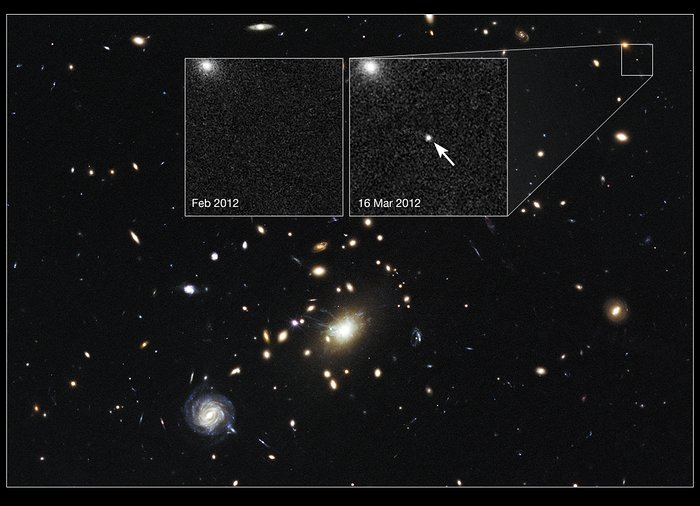Cosmic lens RXJ1532.9+3021 helps Hubble to find a distant supernova (annotated)
The heart of a vast cluster of galaxies called RXJ1532.9+3021 is shown in this image, taken in visible and near-infrared light by the ESA/NASA Hubble Space Telescope.
The galaxy cluster is so massive that its gravity distorts, brightens, and magnifies light from more distant objects behind it, an effect called gravitational lensing. The small white box at upper right marks the location of an exploding star called a supernova, located far behind the cluster.
An enlarged view of the supernova, nicknamed Didius after the second century Roman emperor Didius Julianus, is shown in the inset image on the right, taken in March 2012. The supernova is the white dot in the center of the image. The bright blob at upper left is the core of the host galaxy. The supernova is seen as it appeared 7 billion years ago.
The inset image on the left, taken in February 2012, shows the same region before the supernova blast. The supernova is a member of a special group of exploding stars called Type Ia, prized by astronomers because they provide a consistent level of peak brightness that makes them reliable for making distance estimates.
Both inset images were taken in visible light with Hubble’s Advanced Camera for Surveys.
Finding a gravitationally lensed Type Ia supernova gives astronomers a unique opportunity to check the optical "prescription" of the foreground lensing cluster. The supernova is one of three exploding stars discovered in the Cluster Lensing And Supernova survey with Hubble (CLASH), and was followed up as part of a Supernova Cosmology Project HST program. CLASH is a Hubble census that probed the distribution of dark matter in 25 galaxy clusters. Dark matter cannot be seen directly but is believed to make up most of the universe's matter.
The image of the galaxy cluster was taken between February and April 2012 by Hubble's Wide Field Camera 3 and Advanced Camera for Surveys.
Credit:About the Image
| Id: | heic1409d |
| Type: | Collage |
| Release date: | 1 May 2014, 19:00 |
| Related releases: | heic1409 |
| Size: | 1200 x 868 px |
About the Object
| Name: | Didius Supernova, RXJ1532.9+3021 |
| Type: | Local Universe : Star : Evolutionary Stage : Supernova Early Universe : Galaxy : Grouping : Cluster Early Universe : Cosmology : Phenomenon : Lensing |
| Category: | Galaxies |
Colours & filters
| Band | Wavelength | Telescope |
|---|---|---|
| Optical B | 435 nm |
Hubble Space Telescope
ACS |
| Optical B | 475 nm |
Hubble Space Telescope
ACS |
| Optical V | 606 nm |
Hubble Space Telescope
ACS |
| Optical R | 625 nm |
Hubble Space Telescope
ACS |
| Infrared I | 775 nm |
Hubble Space Telescope
ACS |
| Infrared I | 814 nm |
Hubble Space Telescope
ACS |
| Infrared z | 850 nm |
Hubble Space Telescope
ACS |
| Infrared | 1.05 μm |
Hubble Space Telescope
WFC3 |
| Infrared | 1.1 μm |
Hubble Space Telescope
WFC3 |
| Infrared J | 1.25 μm |
Hubble Space Telescope
WFC3 |
| Infrared | 1.4 μm |
Hubble Space Telescope
WFC3 |
| Infrared H | 1.6 μm |
Hubble Space Telescope
WFC3 |
